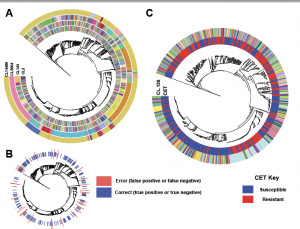So just a quick post about this new paper “Evaluation of Acquired Antibiotic Resistance in Escherichia coli Exposed to Long-Term Low-Shear Modeled Microgravity and Background Antibiotic Exposure“. Seems pretty straightforward… 1000 generations of E. coli in simulated microgravity… expose them to antibiotics and study the development of resistance. This is in contrast to some previous …
This preprint seems like it may be of interest to folks: Precise prediction of antibiotic resistance in Escherichia coli from full genome sequences | bioRxiv Basically, the authors showed that, using a machine learning approach, they can quite accurately predict antibiotic resistance in E. coli from whole genome data. The emergence of microbial antibiotic resistance …
By Amanda Makowiecki Miller Research Group University of Colorado, Boulder With drug resistant bacteria becoming a growing problem, alternative methods are being pursued to decontaminate air and surfaces; ultraviolet germicidal irradiation (UVGI) is one of these methods. UVGI uses short wavelength light in order to disrupt the genetic material of microorganisms, this disruption either kills …
Having been camped out in Portland, OR this week to speak at the 2014 Joint Aquatic Sciences Meeting, I woke up this morning to find a “boil water alert” had been issued for the entire city. Repeated testing over the last few days has found fecal contamination (E. coli) in the city’s reservoirs. So that means a lockdown …
There are a bunch of stories out in relation to work from MIT on “Living Materials” See MIT News Engineers design ‘living materials’ Value Walk MIT Scientists Develop Living Materials Using 3-D Images Of Bacteria Gizmodo MIT’s Living E. Coli Materials Could Provide Self-Aware Surfaces The Register RISE of the LIVING CHAIR: Boffins recruit E coli to build futuristic …
It’s becoming increasingly well-established that microbes behave differently in microgravity than on Earth… that’s one of the justifications for our own Project MERCCURI. Some previous work has focused on the ability of microbes to survive higher-than-normal levels of antibiotics when grown in space, though the mechanism for this is not at all understood. This article …
Just a short post here about “art meets science”. A project at UC San Diego has created “flashing bacterial signs” (also called “biopixels”) that synchronously flash on and off through controlled fluorescence. Which is pretty cool by itself, and reminds me a bit of the stunt with the Contagion promo. See the original paper here. …
This story isn’t so much about the microbiology of the built environment… it’s more about the effect of the built environment on microbiology. A group of researchers from various institutions recently examined the effects of new road construction on the dispersal of antibiotic-resistant bacteria (E. coli in this case). While perhaps not surprising that the …
